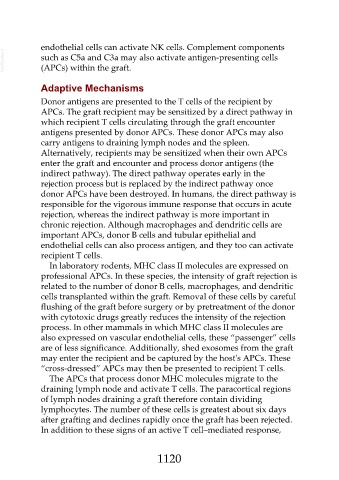Page 1120 - Veterinary Immunology, 10th Edition
P. 1120
endothelial cells can activate NK cells. Complement components
VetBooks.ir such as C5a and C3a may also activate antigen-presenting cells
(APCs) within the graft.
Adaptive Mechanisms
Donor antigens are presented to the T cells of the recipient by
APCs. The graft recipient may be sensitized by a direct pathway in
which recipient T cells circulating through the graft encounter
antigens presented by donor APCs. These donor APCs may also
carry antigens to draining lymph nodes and the spleen.
Alternatively, recipients may be sensitized when their own APCs
enter the graft and encounter and process donor antigens (the
indirect pathway). The direct pathway operates early in the
rejection process but is replaced by the indirect pathway once
donor APCs have been destroyed. In humans, the direct pathway is
responsible for the vigorous immune response that occurs in acute
rejection, whereas the indirect pathway is more important in
chronic rejection. Although macrophages and dendritic cells are
important APCs, donor B cells and tubular epithelial and
endothelial cells can also process antigen, and they too can activate
recipient T cells.
In laboratory rodents, MHC class II molecules are expressed on
professional APCs. In these species, the intensity of graft rejection is
related to the number of donor B cells, macrophages, and dendritic
cells transplanted within the graft. Removal of these cells by careful
flushing of the graft before surgery or by pretreatment of the donor
with cytotoxic drugs greatly reduces the intensity of the rejection
process. In other mammals in which MHC class II molecules are
also expressed on vascular endothelial cells, these “passenger” cells
are of less significance. Additionally, shed exosomes from the graft
may enter the recipient and be captured by the host's APCs. These
“cross-dressed” APCs may then be presented to recipient T cells.
The APCs that process donor MHC molecules migrate to the
draining lymph node and activate T cells. The paracortical regions
of lymph nodes draining a graft therefore contain dividing
lymphocytes. The number of these cells is greatest about six days
after grafting and declines rapidly once the graft has been rejected.
In addition to these signs of an active T cell–mediated response,
1120

